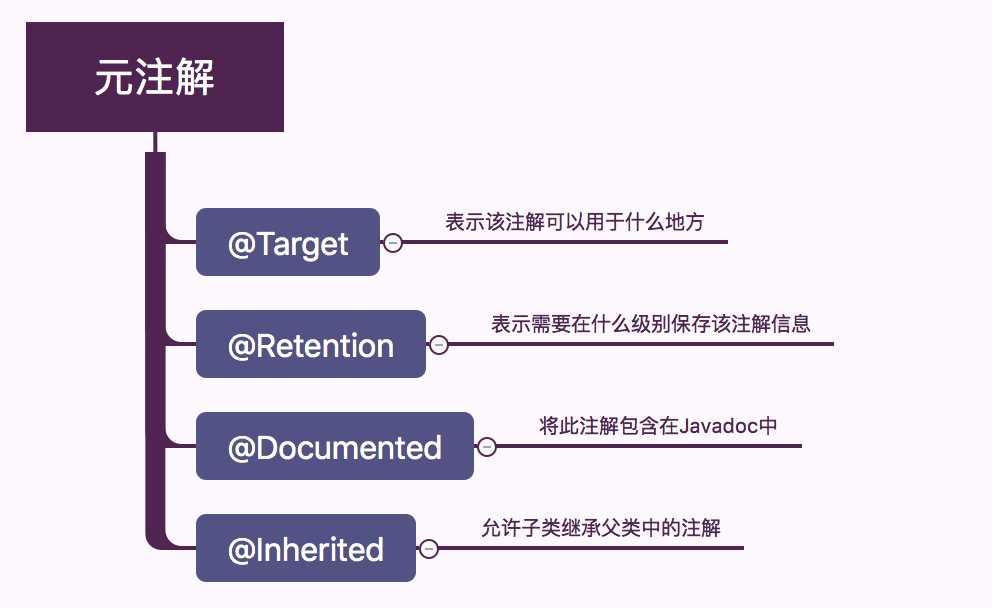标签:reflect ram 使用 引入 rem eric ida least OLE



package java.lang.annotation; /** * @author Joshua Bloch * @since 1.5 * @jls 9.6.4.1 @Target * @jls 4.1 The Kinds of Types and Values */ public enum ElementType { /** Class, interface (including annotation type), or enum declaration */ TYPE, /** Field declaration (includes enum constants) */ FIELD, /** Method declaration */ METHOD, /** Formal parameter declaration */ PARAMETER, /** Constructor declaration */ CONSTRUCTOR, /** Local variable declaration */ LOCAL_VARIABLE, /** Annotation type declaration */ ANNOTATION_TYPE, /** Package declaration */ PACKAGE, /** * Type parameter declaration * * @since 1.8 */ TYPE_PARAMETER, /** * Use of a type * * @since 1.8 */ TYPE_USE }

package java.lang.annotation; /** * @author Joshua Bloch * @since 1.5 */ public enum RetentionPolicy { /** * Annotations are to be discarded by the compiler. */ SOURCE, /** * Annotations are to be recorded in the class file by the compiler * but need not be retained by the VM at run time. This is the default * behavior. */ CLASS, /** * Annotations are to be recorded in the class file by the compiler and * retained by the VM at run time, so they may be read reflectively. * * @see java.lang.reflect.AnnotatedElement */ RUNTIME }
@Target(ElementType.METHOD) @Retention(RetentionPolicy.RUNTIME) public @interface UseCase { public int id(); public String description() default "no description"; }
public class PasswordUtils { @UseCase(id = 47, description = "Passwords must contain at least one numeric") public boolean validatePassword(String password) { return (password.matches("\\w*\\d\\w*")); } @UseCase(id = 48) public String encryptPassword(String password) { return new StringBuilder(password).reverse().toString(); } @UseCase(id = 49, description = "New passwords can‘t equal previously used ones") public boolean checkForNewPassword( List<String> prevPasswords, String password) { return !prevPasswords.contains(password); } }
public class UseCaseTracker { public static void trackUseCases(List<Integer> useCases, Class<?> cl) { for (Method m : cl.getDeclaredMethods()) { UseCase uc = m.getAnnotation(UseCase.class); if (uc != null) { System.out.println("Found Use Case: " + uc.id() + " " + uc.description()); useCases.remove(new Integer(uc.id())); } } for (int i : useCases) { System.out.println("Warning: Missing use case-" + i); } } public static void main(String[] args) { List<Integer> useCases = new ArrayList<Integer>(); Collections.addAll(useCases, 47, 48, 49, 50); trackUseCases(useCases, PasswordUtils.class); } }
Found Use Case: 47 Passwords must contain at least one numeric Found Use Case: 48 no description Found Use Case: 49 New passwords can‘t equal previously used ones Warning: Missing use case-50
标签@UseCase由UseCase.java定义,其中包括int元素id,以及一个String元素description。
注解元素可用的类型如下(否则编译器报错):
注解元素必须要么具有默认值,要么在使用注解时提供元素的值。
注解不支持继承。(见Thinking in Java Fourth Edition 20.2.4)
标签:reflect ram 使用 引入 rem eric ida least OLE
原文地址:https://www.cnblogs.com/guowangrumeng/p/9003861.html